
Regular physical activity is a key component of a healthy lifestyle for individuals of all ages and abilities. For those on the autism spectrum, exercise offers a wide range of benefits that can positively impact physical, emotional, and social well-being. Yet, navigating the world of physical activity can come with its unique set of challenges and considerations for individuals with autism and their caregivers.
This document aims to explore the myriad benefits of exercise for those with autism, along with practical tips and precautions to ensure a positive, safe, and inclusive experience. Join us as we highlight the significance of exercise in enhancing the quality of life for individuals on the autism spectrum, emphasizing the importance of personalized, adaptable approaches to fitness.
Benefits of Exercise for Individuals with Autism
Exercise for individuals with autism is not just about physical health; it’s a gateway to improved cognitive function, better sleep patterns, and heightened sensory processing abilities. Regular physical activity can reduce behaviors that are challenging and promote overall emotional balance, contributing to a more focused and calm demeanor. Let’s take a closer look at some of the specific benefits.
Enhanced Social Skills
Among the myriad benefits, exercise offers individuals with autism an opportunity to develop and refine social skills. This improvement is often observed through interactions in group sports or activities, where children are encouraged to develop relationships with their peers and coaches. Physical activities can be a medium through which social skills in autistic children improve, as they learn to express themselves more effectively, understand the notion of turn-taking, and develop the capacity to adhere to rules and instructions within a social context. These experiences are sure to promote physical health and contribute significantly to the social and emotional growth of autistic children, preparing them for more varied and fulfilling social interactions in their everyday lives.
Better Sensory Processing
Physical activities also serve as an excellent means for individuals with autism to improve sensory processing. Many individuals on the spectrum may experience hypersensitivity or hyposensitivity to sensory inputs, making certain environments or activities challenging. Engaging in exercise can also regulate the sensory system, allowing individuals to better process and respond to sensory information.
Swimming, for instance, can be a particularly beneficial exercise for those with autism as the water pressure and contact provide calming sensory input. Activities like yoga or martial arts incorporate body awareness and control, which can improve proprioception and vestibular processing.
Reduced Behavioral Issues
Individuals with autism may exhibit challenging behaviors, such as aggression, self-stimulation, or noncompliance. Regular exercise can serve as an outlet for individuals to release excess energy and tension, leading to a decrease in these behaviors. It also offers a positive and healthy means of coping with stress, anxiety, and frustration.
Exercise has been shown to increase levels of endorphins, serotonin, and dopamine in the brain. These neurotransmitters regulate mood, emotions, and behavior. As such, engaging in physical activity can contribute significantly to emotional balance and overall well-being.
Improved Motor Skills
Individuals with autism often experience motor skill delays or impairments, which can affect their daily activities and overall quality of life. Physical activity offers an opportunity to develop gross and fine motor skills in a fun, engaging, and supportive environment. Through exercises such as running, jumping, throwing, kicking, and balancing, individuals with autism can enhance their coordination, balance, strength, and flexibility. Even simple activities like playing with balls, riding a bike, or climbing on playground equipment can contribute to the development of fundamental motor skills.
Tips for Engaging in Exercise
Engaging individuals with autism in exercise requires thoughtful planning and a personalized approach to address their unique needs and preferences. Here are several tips to facilitate a positive physical activity experience:
- Start with Short Sessions: Initially, keep exercise sessions short and gradually increase the duration as comfort and endurance improve.
- Incorporate Interests: Tailor activities to include the interests of the individual, whether it’s a specific sport, being in nature, or incorporating favorite characters or themes.
- Use Visual Supports: Visual schedules, timers, and cues can help provide structure and reduce anxiety about transitions and expectations.
- Provide Clear Instructions: Break down tasks into simple, clear steps to ensure understanding and success.
- Ensure a Safe Environment: Create a safe, predictable space for physical activity, considering sensory sensitivities and safety concerns.
- Foster Social Connections: When appropriate, encourage participation in group activities or sports to foster social skills in a supportive setting.
- Celebrate Achievements: Acknowledge progress and effort to build confidence and motivation, no matter how small the achievement may seem.
Precautions to Consider
While exercise is significantly beneficial for individuals with autism, consider specific precautions to ensure their safety and comfort. Let’s take a look at a few essential considerations to keep in mind.
Consult with a Healthcare Professional
Before initiating any new exercise program, consult with a healthcare professional familiar with the individual’s medical history and specific needs. This step ensures that the chosen activities are safe and suitable, considering any co-occurring conditions or physical limitations that might affect participation.
A healthcare professional can offer valuable guidance on modifying exercises to accommodate the individual’s abilities while minimizing risks. These professionals can provide recommendations on the frequency and intensity of exercise that would be most beneficial, supporting a positive and healthful experience.
Consider Sensory Needs
Individuals with autism may have specific sensory sensitivities that could affect their experience while engaging in physical activity. Consider these needs when choosing exercises and modify the environment accordingly to avoid overstimulation or discomfort.
If an individual is sensitive to loud noises, try to find a quieter space for the activity. If they are sensitive to bright lights, consider using dimmer lighting or sunglasses. It may also be helpful to introduce new textures gradually and provide sensory tools such as fidgets or weighted items to promote focus and comfort.
Be Mindful of the Temperature
Individuals with autism may have difficulty regulating their body temperature, leading to heat exhaustion or other adverse reactions during physical activity. Be mindful of this, and plan activities accordingly. If exercising outdoors, choose cooler times of the day, provide plenty of water breaks, and take breaks in shaded areas.
Integrating exercise into the lives of individuals with autism is a step towards unlocking numerous benefits that extend far beyond physical health. From enhancing social skills and motor abilities to improving sensory processing and reducing behavioral issues, physical activity offers a holistic approach to empowering those on the autism spectrum.
With consideration of individual needs, preferences, and sensory sensitivities, practitioners, caregivers, and individuals themselves can create a safe, enjoyable, and beneficial exercise routine. By fostering an inclusive and adaptable fitness environment, we pave the way for a more engaged, healthy, and balanced life for individuals with autism.

















Follow Us